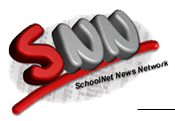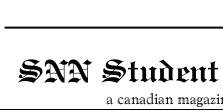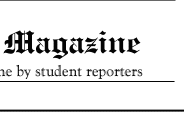 |
 |
|||||
 |
||||||
 |
||||
 |
||||
 |
||||
|
JOURNALISM TIP
Reporting for Radio (some of the information contained here has been used with permission of Radio Diaries http://www.radiodiaries.org/makeyourown.html) Using voices and sounds to tell a story are great ways to get your views/points across to an audience. Radio can be a news report; a commentary, a conversation. It can be an audio postcard. Here are some ways to report using audio. Keep an audio journal ~ Use the tape recorder as an electronic diary. Relax and try to forget about the microphone. Speak the way you do normally. Imagine that you're just talking to a friend. Being natural takes practice. Do interviews ~ Talk to your family, your friends, your bus driver, the fireman down the street. Get people to tell you their stories. Story Ideas ~ Just about anything can make a good radio story. A profile on where you live, your school, your family history, how teens in your school feel about their community and their futures. A special occasion - Christmas and Christmas traditions unique to your community, New Years Eve, Drama in your school. It can be about an issue that affects you. Sample Story Formats: Be curious ~ Think like a reporter. The best thing about carrying around a tape recorder is that it gives you permission to ask people about themselves. Sometimes you find yourself talking to people – even friends and family – about things you would never talk about without a microphone. Being a reporter is a license to be curious. Paint a picture with your voice ~ Be a play-by-play announcer. Tell us where you are, who you're talking to, the date, the time, what's happening. Be the listeners' eyes and ears. Show, don't tell ~ Be creative and pay attention to words, sound and language. Good tour guides do more than just talk, they show. There are tricks for "showing" things on the radio. You can actually point to objects, for example: "over there on the sidewalk is a big blue dog." Even though the listener can't see the dog, a space is created in our imagination for where the blue dog should be. You can often use the microphone the same way you would a movie camera: panning, cutting, zooming in for a close-up. All of these things help create a picture inside our heads. It may sound funny, but radio is a very visual medium. You have to give listeners something to "look" at... with their imagination instead of their eyes. Use the small details to tell the big stories Look for the little things that surprise you. Here's an example: Mrs. Jones is forty-five years old, a doctor, has a family and a dog. But even more interesting — and revealing — is the fact that Mrs. Jones sets every single clock in her house five minutes fast, and that she collects bus transfers from her commute to work and keeps them all in a shoe box in the closet. You can learn a lot about people from a few unexpected details. Be there ~ Let things happen in front of your tape recorder. Record in the moment, instead of telling us about it later. The best documentaries are the ones that let the audience participate and experience things as they happen. There are two types of tape: verb tape (action) and adjective tape (description). Adjective tape is good, but verb tape is more powerful because it pulls the listener inside your story. More verbs. Less adjectives. Be prepared, don't leave home without it If you want things to "happen" in your story, you have to carry your tape recorder with you as much as possible. You should be prepared to be in the right place at the right time. (At news events you can always tell the lazy reporters from the good ones: hack reporters just come for the sound bites; good reporters get there early and stay until the last person leaves.) You never know when you will stumble onto something that will be the best part of your story. Being lucky requires a lot of work. Keep it rolling ~ The golden rule of radio is that the best moments always happen right when you've stopped recording. There's a reason for that: as soon as you push "stop," people relax and are more themselves. Natural, truthful moments are priceless. Tape is cheap. Keep it rolling. Always strive for one "memorable moment". Every story should have at least one little part that you just completely love: a great clip of tape, a good scene, a funny anecdote, an unexpected detail. It's the thing you run back and tell your friends about. Often the "memorable moment" is something that catches you by surprise. TECHNICAL TIPS Get organized. Always make sure you have enough cassettes and an extra set of batteries. Don't leave long cables hanging out, or you'll have to spend time untangling everything. Get a shoulder bag to hold the recorder, the cassettes and batteries. The more prepared you are, the more you can concentrate on the important things. Do a test. Always do a test before you begin. Record a few seconds, then play it back to make sure the sound is good. Label your tapes. Always label the tapes before you start. When you're in the field it's easy to forget and tape over something you've just recorded. (It happens.) Always wear your headphones. Recording without headphones is like a photographer taking pictures without looking through the viewfinder. Headphones help you focus on exactly what you're recording. If something sounds weird, stop and check it out. Beware of the pause button. When recording, make sure the tape is rolling and that you're not in pause mode. Don't use the pause button. It's a very tricky little button — it can make you think you are recording when you're not. Keep the microphone close. The most important thing of all: keep the microphone close to the sound source (your mouth or the mouth of the person you're interviewing). About 5-6 inches is good, the length of your outstretched hand. If it's any farther away you will still be able to hear what people say, but the recording will lose its power and intimacy. It's also best to keep the microphone a little bit below the mouth to avoid the "popping P" sound. Collect good sounds. Every time you record, collect all the specific sounds you can think of: dogs barking, the sound of the ocean, students in the hallways, sounds from a sporting event, doors slamming, the radio being turned on, the sound of your blender. Be creative. You will use these sounds later when you produce the story. Record everything. Long pauses are okay. Umms are okay. Saying stupid and embarrassing things is okay. Often the stuff you think is weird, worthless, or that you initially want to edit out, will end up being the best and most surprising parts of the story. LINKS: http://www.radiodiaries.org/makeyourown.html http://radio.cbc.ca/programs/outfront |
|